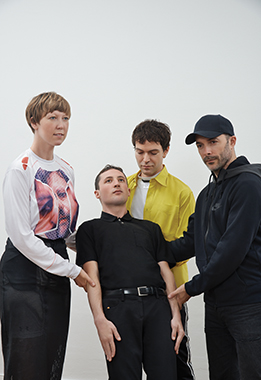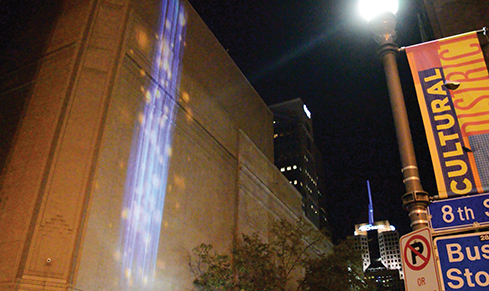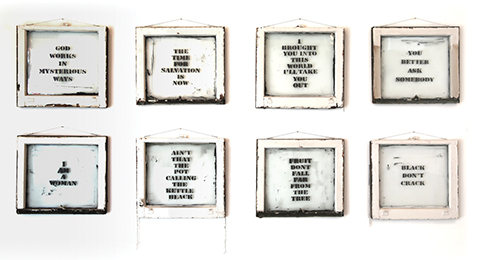 |
||||||||||
Photography here and now: Light, time, and socially engaged art in Pittsburgh“I think that clock just took a picture of us.”You’re walking down Forbes Avenue, past Carnegie Museum of Art, when these strange words catch your ear. Curious, you look toward the museum’s front plaza and see two people gazing up at an 8-foot clock that looks like it could grace any small town square in America. Extending from the base of the clock, a bright red line traces a path to the museum’s front doors. You step closer. Your sense that things are not what they seem intensifies: this clock only has one hand, and no numbers. As the hand slowly passes over where the six would be, the face begins to illuminate and a ticking sound you hadn’t noted before accelerates. You wait. The ticking crescendos just as the hand reaches twelve o’clock and, click!, you hear a shutter release. You follow the bright red line into the museum where you see yourself on a digital screen on the wall, which seems to combine multiple images taken of the plaza. Yep, that clock definitely just took my picture.
This picture-taking clock, named the Light Clock, is the newest embodiment of the Hillman Photography Initiative at Carnegie Museum of Art, an incubator for exploring the rapidly shifting field of photography and its impact in the world today. Over the next 15 months, the Initiative will launch LIGHTIME, four artist-led projects that investigate contemporary issues from social justice to environmental sustainability. Some of these projects will take place with and within Pittsburgh communities. Some will manifest digitally. But all of them, like the Light Clock, will be activated by photography’s measurement of light and time. The Light Clock, designed by the Innovation Studio at Carnegie Museums of Pittsburgh, serves as a beacon and home base for LIGHTIME.
Late last year, the museum convened a four-month planning process with a truly inspiring group of agents: Brooklyn-based artist Steffani Jemison; New York-based artist Liz Deschenes; Yale professor of Women’s, Gender, and Sexuality Studies and American Studies, Laura Wexler; and Carnegie Museum of Art curator of photography, Dan Leers. From the start, the group was captivated by the connection between photography and light. How did photography measure light down to the sub-microscopic level of the photon? Our conversations, facilitated by design researchers at Pittsburgh-based MAYA Design, Inc., quickly expanded to consider the macroscopic, social implications of light: Who gets access to light? How is access impacted by race, class, and gender? How are clean air and light measured? And, specifically: How are these questions relevant to Pittsburgh? All four agents insisted that, whatever form our programming took, it had to be rooted in Pittsburgh, drawing connections between the museum and its surrounding communities. As an architectural and urban historian with a particular interest in the community impact of social and infrastructural variables, this was music to my ears. As a museum professional invested in building bridges between museums and communities, I was in seventh heaven. Rallying around the central theme of light, time, and measurement in photography, the group became particularly inspired by a piece of writing by philosopher and critical theorist Roland Barthes. At a particularly poignant moment in Camera Lucida: Reflections on Photography, Barthes writes, “For me the noise of Time is not sad: I love bells, clocks, watches—and I recall that at first photographic implements were related to techniques of cabinetmaking and the machinery of precision: cameras, in short, were clocks for seeing, and perhaps in me someone very old still hears in the photographic mechanism the living sound of the wood.”
This beautiful quote resonates with four upcoming projects that invite artists to activate photography’s measurement of light and time to investigate contemporary social issues. LIGHT & ENVIRONMENTAL SUSTAINABILITY will invite Santa Fe-based international artist Andrea Polli to lead a series of events examining light quality and energy consumption in Pittsburgh. Following the installation of her digital work Particle Falls on the façade of the Benedum Center in 2014, this winter she will return to Pittsburgh to continue and extend conversations about environmental sustainability that began two years ago. How can the visualization of data build personal awareness that mitigates our impact on local environments? Polli will ask us to consider this question during a series of tours and workshops examining how we sense and experience environmental data. This series will explore the parameters of digital imaging, which at its essence is the visualization of data from ambient light, and prompt consideration of the ways in which the visualization of environmental data can be photographic, too. Her project will encourage conversations about our personal stake in local air quality and energy consumption and, ultimately, yield a publication. LIGHT & PERCEPTION will invite the New York-based artist collective DIS to explore how computational photography technologies change the way we perceive light, space, and objects in virtual worlds. A relatively new field, computational photography combines cutting-edge research in camera technology, computer vision, and graphics. These technologies increase the capabilities of digital photography and are essential in the development of virtual reality and gaming environments. DIS will consider pressing questions such as how people, places, and things are represented digitally. Who, for instance, makes the decisions about how difference is portrayed and perceived? In spring 2017, this project will encourage us to examine how the inherent biases embedded in computational photography define the way our visual environment is represented in the virtual realm. Ultimately, we hope to create a virtual environment for audience exploration. Like the Initiative, which is built to quickly respond to timely issues, our projects often unroll in real time, with future outcomes that shift as variables fall into place. Stay tuned!
LIGHT & MOVEMENT, premiering in summer 2017, will commission cinematographer and video installation artist Bradford Young to create a piece inspired by Pittsburgh’s tunnels and the connections between light, vision, movement, and time. Young, acclaimed for his photographic direction of films such as Selma and A Most Violent Year, is known for video work that considers the narrative effects of natural, ambient light and engages cultural memory, myth, and history. Young has proposed a multichannel video installation exploring Pittsburgh tunnels not only as literal passageways into the city but also as metaphors for the Great Migration, the exodus of more than six million African-Americans from the rural South to cities across the Northeast, Midwest, and West between 1915 and 1970. How has Pittsburgh’s collective memory been shaped by its histories of migration and first arrivals? Deeply inspired by the work of photographer Charles “Teenie” Harris and playwright August Wilson, Young will explore this question within the context of Pittsburgh’s Hill District while also inviting us to consider the continuum of artistic practice between photography and the moving image. LIGHT & SOCIAL JUSTICE will ask Pittsburgh-based artist Alisha B. Wormsley to develop a series of public projects that activate vacant or abandoned properties and explores the connection between light and social justice in Pittsburgh. Wormsley’s interdisciplinary practice combines photography with video and sculpture to consider collective memory across locales and time periods. She manages the Homewood Artist Residency, a program initiated by The Andy Warhol Museum in 2010 that recognizes African-American art and culture and seeks to build relationships between artists and the Homewood community. Starting in fall 2017, she’ll investigate the past, present, and future of Homewood by curating and photographically documenting a series of artist-led installations that will create spaces for local conversation, reflection, and engagement. These projects are some of the most exciting I have ever worked on in a museum. What heartens me most is their social relevance. After attending the American Alliance of Museums annual conference this past May, it’s increasingly clear that the Hillman Photography Initiative’s process is allowing us to keep our finger on the pulse of what’s driving conversations today about the future of photography, and of museums at large. For me, the critical takeaway of that conference was that professionals everywhere are pushing the boundaries of what museums can do and be for their communities, as gathering places to converse about issues of social justice, equity, diversity, and inclusion. I could not be more proud, or more humbled, by the aspirations of LIGHTIME, which will unfold over the next year and a half. I hope that you will join us as we explore what photography can be, here and now, in Pittsburgh!
|
||||||||||
Organizing Delirium · My Perfect, Imperfect Body · Body Boundaries · A Woman's World · President's Note · NewsWorthy · Face Time: Laura Micco · Artistic License: Making Some Noise · Travel Log · The Big Picture
 |
Copyright © 2017 CARNEGIE Magazine. All rights reserved. |




